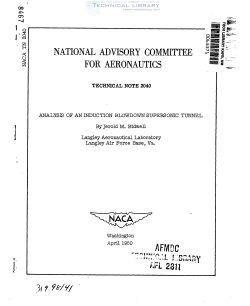naca-tn-2040
- Version
- 100 Downloads
- 807.93 KB File Size
- 1 File Count
- December 14, 2016 Create Date
- December 14, 2016 Last Updated
National Advisory Committee for Aeronautics, Technical Notes - Analysis of an Induction Blowdown Supersonic Tunnel

General ejector equations and certain assumptions with regard to
flow conditions and pressure losses are used to calculate the running
times for one type of induction blowdown supersonic tunnel for Mach
numbers of l to 2 and for reservoir pressures of 2 to h atmospheres.
For a given reservoir and for given test—section size and conditions,
the running time has a maximum with respect to the area and static pres-
sure or stagnation temperature of the inducing jet. *
The results show that for a given test-section area, the running
time increases‘with test-section Mach number up to about 1.35; after
which the running time decreases rapidly. A Reynolds number comparison
of the induction tunnel with a direct-discharge tunnel shows that for
the same running time the Reynolds number of the induction tunnel will
be greater than that of the direct-discharge tunnel at Mach numbers up
to 1.93 for a reservoir pressure of h atmospheres.
Wind tunnels with large test sections for low supersonic speeds
(M = l.0 to M = 2.0) are in demand. When short running times are
satisfactory and cost is a primary objective, it may be desirable to
consider a blowdown type of wind tunnel. The feasibility of such an
arrangement is specially enhanced if a large hithpressure reservoir is
already available. If, in the interest of economy, a small power plant
is used, a great deal of time will be required between runs to pump up
the reservoir. Blowdown tunnels, of course, require special equipment
if moisture condensation is serious.
Blowdown tunnels are generally of two types: the direct—discharge
tunnel and the induction tunnel. The direct-discharge type of blowdown
tunnel uses air from a high-pressure'reservoir to provide the mass flow
through the test chamber and to provide energy for the losses in the
system. This type is relatively simple, but very wasteful in that, near
the beginning of the run, the pressure of the reservoir air is far in
excess of that required to overcome the losses in the tunnel. Throta
tling-over such a large pressure drop results in relatively large deg-
radation of energy. The induction type of blowdown tunnel uses air
from a high-pressure reservoir only to provide energy to overcome the
losses. Since higher pressures are used in the induction process,
energy degradation due to throttling occurs to a much smaller degree.
Actually, however, the induction process itself involves inherent
mixing losses, and certain of the basic blowdown losses are also
retained, so that no simple statement on the_relative efficiencies of
the two types can be made.
| File | Action |
|---|---|
| naca-tn-2040 Analysis of an Induction Blowdown Supersonic Tunnel.pdf | Download |

Comment On This Post